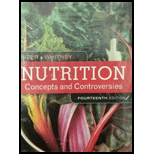
Bundle: Nutrition: Concepts and Controversies, Loose-leaf Version, 14th + LMS Integrated for MindTap Nutrition, 1 term (6 months) Printed Access Card
14th Edition
ISBN: 9781337127547
Author: Frances Sizer, Ellie Whitney
Publisher: Cengage Learning
expand_more
expand_more
format_list_bulleted
Concept explainers
Question
Chapter 13, Problem 2CT
Summary Introduction
To analyze:
A picture that represents the concept of energy balance that we could use as a visual aid in explaining the concept to a 10-to12- years old.
Introduction:
To avoid obesity, it is necessary to maintain a balance between the intake of food and the energy needed. The balance between them is known as energy balance. It can be easily estimated through body mass index (BMI).
Expert Solution & Answer
Want to see the full answer?
Check out a sample textbook solution
Chapter 13 Solutions
Bundle: Nutrition: Concepts and Controversies, Loose-leaf Version, 14th + LMS Integrated for MindTap Nutrition, 1 term (6 months) Printed Access Card
Ch. 13 - Prob. 1RQCh. 13 - Prob. 2RQCh. 13 - Prob. 3RQCh. 13 - Prob. 1CTCh. 13 - Prob. 2CTCh. 13 - Prob. 1SCCh. 13 - Prob. 2SCCh. 13 - A deficiency of which nutrient during pregnancy...Ch. 13 - Prob. 4SCCh. 13 - Which of the following preventative measures...
Ch. 13 - Prob. 6SCCh. 13 - Prob. 7SCCh. 13 - Prob. 8SCCh. 13 - Without proper management, type 1 or type 2...Ch. 13 - Prob. 10SCCh. 13 - Prob. 11SCCh. 13 - Prob. 12SCCh. 13 - Prob. 13SCCh. 13 - Prob. 14SCCh. 13 - Prob. 15SCCh. 13 - Prob. 16SCCh. 13 - Prob. 17SCCh. 13 - Prob. 18SCCh. 13 - Prob. 19SCCh. 13 - Prob. 20SC
Knowledge Booster
Learn more about
Need a deep-dive on the concept behind this application? Look no further. Learn more about this topic, health-nutrition and related others by exploring similar questions and additional content below.Similar questions
- Along the lines of question 3, formulate a healthy diet for an actively growing 7-year-old.arrow_forwardWhen a child has a chronic condition that limits activity, such as spina bifida, what is the greatest long-term nutrition concern? a. Protein limiting growth b. Modified food textures to avoid eating difficulties c. Excessive calorie intake further limiting mobility d. Intake of calcium and vitamin D to prevent bone fracturesarrow_forwardSome nutritionists claim that the secret to long life is to be slightly underweight as an adult. If a persons weight is related partly to diet, partly to activity level, and partly to genetics, what underlying factors could be at work to generate statistics that support this claim?arrow_forward
Recommended textbooks for you
 Human Physiology: From Cells to Systems (MindTap ...BiologyISBN:9781285866932Author:Lauralee SherwoodPublisher:Cengage Learning
Human Physiology: From Cells to Systems (MindTap ...BiologyISBN:9781285866932Author:Lauralee SherwoodPublisher:Cengage Learning Nutrition: Concepts and Controversies - Standalo...Health & NutritionISBN:9781305627994Author:Frances Sizer, Ellie WhitneyPublisher:Brooks ColeLifetime Physical Fitness & WellnessHealth & NutritionISBN:9781337677509Author:HOEGERPublisher:Cengage
Nutrition: Concepts and Controversies - Standalo...Health & NutritionISBN:9781305627994Author:Frances Sizer, Ellie WhitneyPublisher:Brooks ColeLifetime Physical Fitness & WellnessHealth & NutritionISBN:9781337677509Author:HOEGERPublisher:Cengage



Human Physiology: From Cells to Systems (MindTap ...
Biology
ISBN:9781285866932
Author:Lauralee Sherwood
Publisher:Cengage Learning

Nutrition: Concepts and Controversies - Standalo...
Health & Nutrition
ISBN:9781305627994
Author:Frances Sizer, Ellie Whitney
Publisher:Brooks Cole

Lifetime Physical Fitness & Wellness
Health & Nutrition
ISBN:9781337677509
Author:HOEGER
Publisher:Cengage
